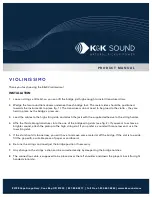
3. INSTALLATION
3.1 Installation Precautions
(1) Ambient Temperature
Avoid locations that are subjected to considerable
temperature variations and fluctuations. When the
installation site is subjected to heat radiation from
the plant, adopt insulation measures or ensure
adequate ventilation.
(2) Atmospheric Conditions
Avoid installing the vortex flowmeter in a corrosive
atmosphere. When the vortex flowmeter must be
installed in a corrosive atmosphere, take measures
to ensure adequate ventilation, and prevent the
entry or build-up of rain water in wiring ducts.
(3) Mechanical Shock or Vibration
The vortex flowmeter has been designed to be a
strong structure. However, install it at a location
that is subjected to minimal mechanical shock or
vibration.
If the flowmeter is subjected to vibrations, it is
recommended that pipeline supports are provided
as shown in Figure 3.1.
Vortex Flowmeter
Piping line
Piping support
F0301.ai
Figure 3.1 Example of Pipeline Support
(4) Piping Line
When passing fluids along the piping line of the
vortex flowmeter, pay attention to the following
points to ensure safe and accurate use.
(a) Make sure that the connector bolts for installing the
vortex flowmeter and piping line are tightened firmly.
(b) Make sure that there are no leaks on the piping.
(c) Do not apply a pressure higher than the specified
maximum working pressure.
(d) Do not loosen or tighten the flange mounting bolts
when the assembly is pressurized. Be sure to
depressurize the piping line before doing this.
(e) Handle the vortex flowmeter carefully when
measuring toxic liquids, so that the liquids do not
splash into the eyes or face. When using toxic gases,
be careful not to inhale them.
(5) Other
• Choose a location where there is sufficient
clearance around the vortex flowmeter to allow
work such as routine inspection.
• Choose a location that allows easy wiring and
piping.
<3. Installation>
10
IM 01F07A01-01EN












































